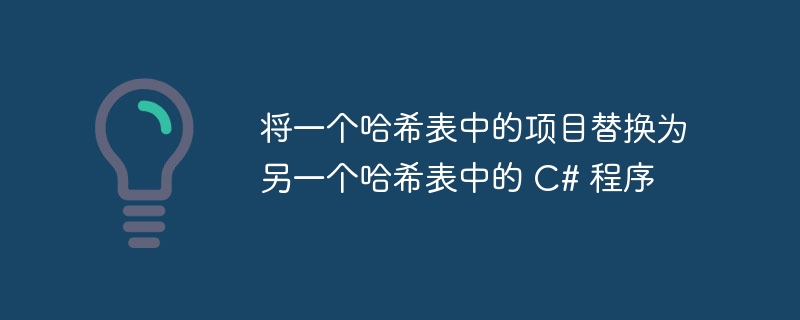

A hash table collection in C# is a non-generic collection of key-value pairs organized based on the hash code of the key. Keys are used to access elements in a hash table collection. Hashing helps us retrieve data efficiently and eliminates the need for expensive data search techniques. Hashing techniques use the key itself to locate the data. The hash table key is immutable and duplicate entries are not allowed in the hash table.
The Hashtable class is defined in the System.Collections namespace and provides a base class library for hash table collections in C#. This Hashtable class is used to create a collection of key-value pairs stored in a hash table. The lookup for a specific key is optimized by calculating the hash code of the key and storing it in another basket. When we access a value from the hash table, it matches the hash code with the specified key.
In this tutorial, we will discuss a way to replace an item or element in a hash table with an item or element in another hash table.
The Hashtable class discussed above provides constructors for creating Hashtable objects and methods for adding, removing elements, and checking whether an element, key, or value exists in the hashtable. It also provides properties for checking whether the hashtable is empty, calculating the number of elements in the hashtable, etc.
But it does not allow our method to replace an entire hash table item from another hash table. We can replace individual items by replacing values.
To replace the contents of the entire hash table with the contents of another hash table, usually we will traverse the entire second hash table and replace the contents of the first hash table with the second hash table Content.
We will use the method shown below.
foreach (DictionaryEntry item in secondHashtable) {
firstHashtable[item.Key] = item.Value;
Console.WriteLine("{0} ({1}) ", item.Key, item.Value);
}
First, we iterate over the second hash table and replace the key-value pairs of the first hash table with each key-value pair of the second hash table.
The entire program to implement this method is as follows.
using System;
using System. Collections;
class MyHashTable {
// Main Method
static public void Main() {
// Create hashtable using the default constructor
Hashtable indianNumberSystem = new Hashtable();
//add a key/value pair using the Add() method
indianNumberSystem.Add(1,"Ones");
indianNumberSystem.Add(10,"Tens");
indianNumberSystem.Add(100,"Hundred");
indianNumberSystem.Add(1000,"Thousand");
Console.WriteLine("Contents of indianNumberSystem hashtable:");
foreach(DictionaryEntry ele1 in indianNumberSystem){
Console.WriteLine("{0} ({1}) ", ele1.Key, ele1.Value);
}
Hashtable langCodes = new Hashtable();
langCodes.Add("C++","CPlusPlus");
langCodes.Add("C#","CSharp");
langCodes.Add("Java","Java");
langCodes.Add("PL","Perl");
Console.WriteLine("Contents of langCodes Hashtable:");
foreach(DictionaryEntry ele1 in langCodes){
Console.WriteLine("{0} ({1}) ", ele1.Key, ele1.Value);
}
Console.WriteLine("After Replacing with langCodes, indianNumberSystem: ");
foreach (DictionaryEntry item in langCodes) {
indianNumberSystem[item.Key] = item.Value;
Console.WriteLine("{0} ({1}) ", item.Key, item.Value);
}
}
}
Here we have two hash tables, indianNumberSystem and langCodes. We fill two hash tables with values and then display their contents. We then iterate over the langCodes hash table and replace each element of the indianNumberSystem hash table with an element of the langCodes hash table.
The output of this program is shown below.
Contents of indianNumberSystem hashtable: 1000 (Thousand) 10 (Tens) 100 (Hundred) 1 (Ones) Contents of langCodes Hashtable: Java (Java) C# (CSharp) PL (Perl) C++ (CPlusPlus) After Replacing with langCodes, indianNumberSystem: Java (Java) C# (CSharp) PL (Perl) C++ (CPlusPlus)
We can see from the output that after replacement, the content of indianNumberSystem is replaced with the content of langCodes.
Now let's look at the next example.
In this example, we will have two hash tables: indianNumberSystem and numSys. Here we are not filling the hash table indianNumberSystem. We just create an object. The following values were added to the numSys hash table using the Add method.
1 |
one |
10 |
ten |
100 |
one hundred |
1000 |
thousand |
The complete program for this example is as follows.
using System;
using System. Collections;
class MyHashTable {
// Main Method
static public void Main() {
// Create hashtable using the default constructor
Hashtable indianNumberSystem = new Hashtable();
Hashtable numSys = new Hashtable();
numSys.Add(1,"Ones");
numSys.Add(10,"Tens");
numSys.Add(100,"Hundred");
numSys.Add(1000,"Thousand");
Console.WriteLine("Contents of numSys Hashtable:");
foreach(DictionaryEntry ele1 in numSys){
Console.WriteLine("{0} ({1}) ", ele1.Key, ele1.Value);
}
Console.WriteLine("After Replacing with numSys, indianNumberSystem: ");
foreach (DictionaryEntry item in numSys) {
indianNumberSystem[item.Key] = item.Value;
Console.WriteLine("{0} ({1}) ", item.Key, item.Value);
}
}
}
Here we use the same method as the first program, the only difference is that the first hash table is empty. We then directly replace or move the items of the second hash table into the first hash table.
The output of this program is given below.
Contents of numSys Hashtable: 1000 (Thousand) 10 (Tens) 100 (Hundred) 1 (Ones) After Replacing with numSys, indianNumberSystem: 1000 (Thousand) 10 (Tens) 100 (Hundred) 1 (Ones)
As the output of the program shows, the contents of the numSys table are now the contents of indianNumberSystem.
So by using a simple loop and iterating over the hash table we can replace an item in it with another hash table.
The above is the detailed content of C# program to replace items in one hash table with another hash table. For more information, please follow other related articles on the PHP Chinese website!
 The difference between Java and Java
The difference between Java and Java
 Advantages and Disadvantages of Free Overseas Website Servers
Advantages and Disadvantages of Free Overseas Website Servers
 How to read database in html
How to read database in html
 Introduction to the main work content of front-end engineers
Introduction to the main work content of front-end engineers
 mysql engine introduction
mysql engine introduction
 cdr file opening method
cdr file opening method
 What are the mysql update statements?
What are the mysql update statements?
 The most promising coin in 2024
The most promising coin in 2024




